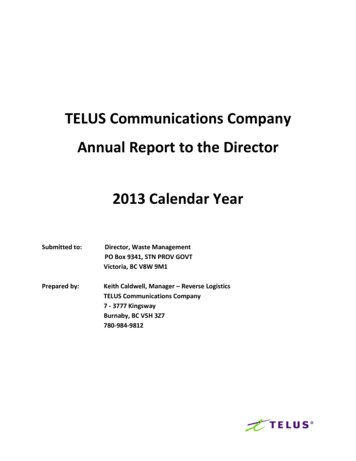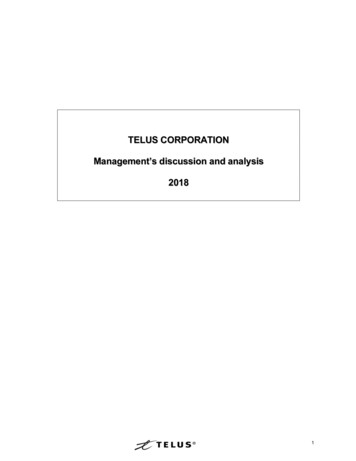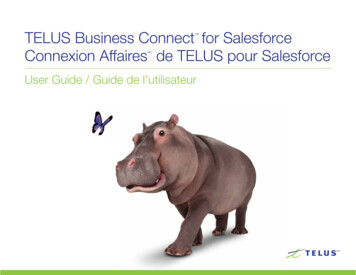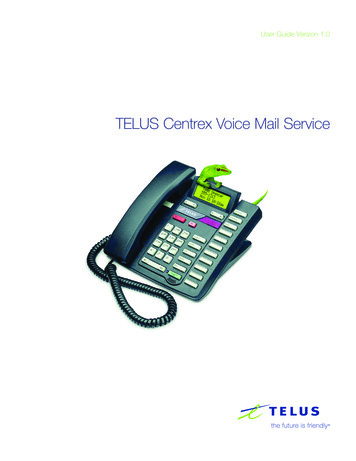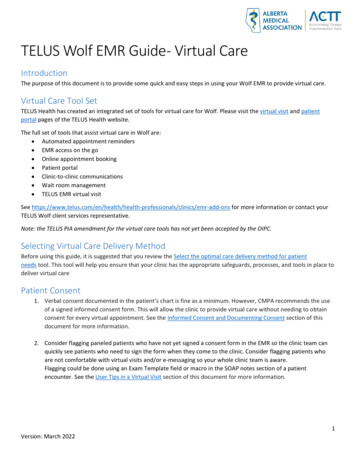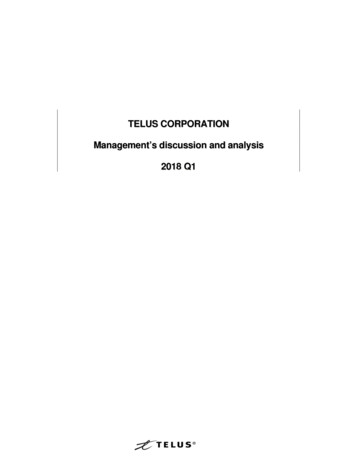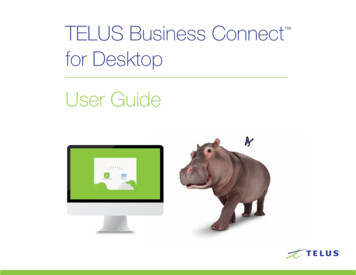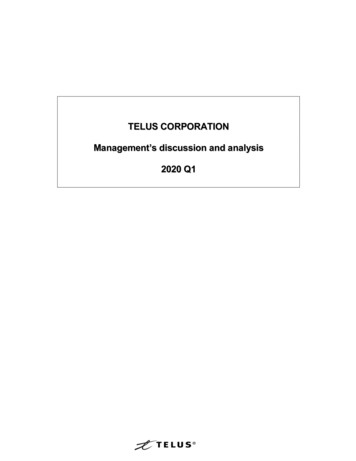
Transcription
TELUS CORPORATIONManagement’s discussion and analysis2020 Q1
TELUS Corporation – Management’s discussion and analysis – 2020 Q1Caution regarding forward-looking statementsThe terms TELUS, the Company, we, us and our refer to TELUS Corporation and, where the context of the narrative permits orrequires, its subsidiaries.This document contains forward-looking statements about expected events and our financial and operating performance.Forward-looking statements include any statements that do not refer to historical facts. They include, but are not limited to,statements relating to our objectives and our strategies to achieve those objectives, our targets, outlook, updates, our plans andexpectations regarding the impact of the COVID-19 pandemic and responses to it, and our multi-year dividend growth program.Forward-looking statements are typically identified by the words assumption, goal, guidance, objective, outlook, strategy, targetand other similar expressions, or future or conditional verbs such as aim, anticipate, believe, could, expect, intend, may, plan,predict, seek, should, strive and will. These statements are made pursuant to the “safe harbour” provisions of applicablesecurities laws in Canada and the United States Private Securities Litigation Reform Act of 1995.By their nature, forward-looking statements are subject to inherent risks and uncertainties and are based on assumptions,including assumptions about future economic conditions and courses of action. These assumptions may ultimately prove tohave been inaccurate and, as a result, our actual results or events may differ materially from expectations expressed in orimplied by the forward-looking statements.Risks and uncertainties that could cause actual performance or events to differ materially from the forward-lookingstatements made herein and in other TELUS filings include, but are not limited to, the following: The COVID-19 pandemic including its impacts on our customers, our team members and our communities, as well aschanges resulting from the pandemic to our business and operations including to the demand for and supply of the productsand services that we offer and the channels through we offer them. Regulatory decisions and developments including changes to our regulatory regime (the timing of announcement orimplementation of which are uncertain) or the outcomes of proceedings, cases or inquiries relating to its application,including but not limited to those set out in Section 9.1 Communications industry regulatory developments and proceedingsin this Management’s discussion and analysis (MD&A), such as the potential for government intervention to further increasecompetition, for example, through mandated wholesale access; the potential for additional government intervention on pricing,including the March 2020 announcement by the federal government targeting a 25% price reduction in wireless plans usingbetween two to six GB of data over a two year period by the national wireless carriers; federal and provincial consumer protectionlegislation and regulation; amendments to existing federal legislation; potential threats to unitary federal regulatory authority overtelecommunications; potential threats to the CRTC’s ability to enforce the Wholesale Code, which aims to ensure the fairtreatment by vertically integrated firms of rival broadcasting distributors and programming services; regulatory action by theCompetition Bureau or other regulatory agencies; spectrum and compliance with licences, including our compliance with licenceconditions, changes to spectrum licence fees, spectrum policy determinations such as restrictions on the purchase, sale,subordination and transfer of spectrum licences, the cost and availability of spectrum, and ongoing and future consultations anddecisions on spectrum allocation; the impact on us and other Canadian telecommunications carriers of government or regulatoryactions with respect to certain countries or suppliers, including the executive order signed by U.S. President Donald Trumppermitting the Secretary of Commerce to block certain technology transactions deemed to constitute national security risks andthe imposition of additional licence requirements on the export, re-export and transfer of goods, services and technology toHuawei Technologies Co. Ltd. and its non-U.S. affiliates; restrictions on non-Canadian ownership and control of TELUS CommonShares and the ongoing monitoring of and compliance with such restrictions; unanticipated changes to the current copyrightregime; and our ability to comply with complex and changing regulation of the healthcare and medical devices industry in thejurisdictions in which we operate, including as an operator of health clinics. Competitive environment including: our ability to continue to retain customers through an enhanced customer serviceexperience, including through the deployment and operation of evolving wireless and wireline infrastructure; intensewireless competition, including the ability of industry competitors to successfully combine a mix of internet services and, insome cases, wireless services under one bundled and/or discounted monthly rate, along with their existing broadcast orsatellite-based TV services; the success of new products, services and supporting systems, such as home automationsecurity and Internet of Things (IoT) services for internet-connected devices; wireline voice and data competition, includingcontinued intense rivalry across all services among wireless and wireline telecommunications companies, cable companies,other communications companies and over-the-top (OTT) services, which, among other things, places pressures on currentand future mobile phone average billing per subscriber per month (ABPU), mobile phone average revenue per subscriberper month (ARPU), cost of acquisition, cost of retention and churn rate for all services, as do customer usage patterns,increased data bucket sizes or flat-rate pricing trends for voice and data, such as our Peace of Mind plans andcomparable plans recently launched, inclusive rate plans for voice and data and availability of Wi-Fi networks for data;mergers and acquisitions of industry competitors; pressures on internet and TV ARPU and churn rate resulting from marketconditions, government actions and customer usage patterns; residential voice and business network access line losses;subscriber additions and retention volumes, and associated costs for wireless, TV and internet services; our ability to obtainand offer content on a timely basis across multiple devices on wireless and TV platforms at a reasonable cost as contentcosts per unit continue to grow; vertical integration in the broadcasting industry resulting in competitors owning broadcastcontent services, and timely and effective enforcement of related regulatory safeguards; our ability to compete successfullyin our TELUS International customer care and business services given our competitors’ brand recognition, consolidationand strategic alliances, as well as technology development; in our TELUS Health business, our ability to compete with otherproviders of electronic medical records and pharmacy management products, systems integrators and health servicePage 2 of 48
TELUS Corporation – Management’s discussion and analysis – 2020 Q1providers including those that own a vertically integrated mix of health services delivery, IT solutions, and related services,and global providers that could achieve expanded Canadian footprints; and our ability to successfully develop our smartdata solutions business. Technological substitution including: reduced utilization and increased commoditization of traditional wireline voice services(local and long distance) resulting from impacts of OTT applications and wireless substitution; a declining overall market forpaid TV services, including as a result of content piracy and signal theft, a rise in OTT direct-to-consumer video offeringsand virtual multichannel video programming distribution platforms; the increasing number of households that have onlywireless and/or internet-based telephone services; potential declines in mobile phone ABPU and ARPU as a result of,among other factors, substitution by messaging and OTT applications; substitution by increasingly available Wi-Fi services;and disruptive technologies, such as OTT IP services, including software-defined networks in the business market, that maydisplace or cause us to reprice our existing data services. Challenges to our ability to deploy technology including: high subscriber demand for data that challenges wireless networksand spectrum capacity levels and may be accompanied by increases in delivery cost; our reliance on informationtechnology and our ability to streamline our legacy systems; the roll-out and evolution of wireless broadband technologiesand systems, including video distribution platforms and telecommunications network technologies (broadband initiatives,such as fibre to the premises (FTTP), wireless small-cell deployment, 5G wireless and availability of resources and ourability to build out adequate broadband capacity); our reliance on wireless network access agreements, which havefacilitated our deployment of wireless technologies; our choice of suppliers and those suppliers’ ability to maintain andservice their product lines, which could affect the success of upgrades to, and evolution of, technology that we offer;supplier limitations and concentration and market power for products such as network equipment, TELUS TV and wirelesshandsets; our expected long-term need to acquire additional spectrum capacity through future spectrum auctions and fromthird parties to address increasing demand for data and our ability to utilize spectrum we acquire; deployment and operationof new wireline broadband network technologies at a reasonable cost and the availability and success of new products andservices to be rolled out using such network technologies; network reliability and change management; and our deploymentof self-learning tools and automation that may change the way we interact with customers. Capital expenditure levels and potential outlays for spectrum licences in auctions or purchases from third parties, affect andare affected by: our broadband initiatives, including connecting more homes and businesses directly to fibre; our ongoingdeployment of newer wireless technologies, including wireless small cells to improve coverage and capacity and prepare fora more efficient and timely evolution to 5G wireless services; investments in network resiliency and reliability; including toaddress changes in usage resulting from restrictions imposed in response to COVID-19; the allocation of resources toacquisitions and future wireless spectrum auctions held by Innovation, Science and Economic Development Canada(ISED), including the 3500 MHz and millimetre wave spectrum auctions currently expected to take place in 2020 and 2021,respectively, and the announcement of a formal consultation on the auctioning of 3800 MHz spectrum, expected to takeplace in 2022. Our capital expenditure levels could be impacted if we do not achieve our targeted operational and financialresults or by changes to our regulatory environment. Operational performance and business combination risks including: our reliance on legacy systems and ability to implementand support new products and services and business operations in a timely manner; our ability to manage the requirementsof large enterprise deals; our ability to implement effective change management for system replacements and upgrades,process redesigns and business integrations (such as our ability to successfully integrate acquisitions, complete divestituresor establish partnerships in a timely manner and realize expected strategic benefits, including those following compliancewith any regulatory orders); our ability to identify and manage new risks inherent in new service offerings that we mayprovide, including as a result of acquisitions, which could result in damage to our brand, our business in the relevant area oras a whole, and additional exposure to litigation or regulatory proceedings. Data protection including risks that malfunctions or unlawful acts could result in unauthorized access to, change, loss, ordistribution of data, which may compromise the privacy of individuals and could result in financial loss and harm to ourreputation and brand. Security threats including intentional damage or unauthorized access to our physical assets or our IT systems andnetworks, which could prevent us from providing reliable service or result in unauthorized access to our information or thatof our customers. Ability to successfully implement cost reduction initiatives and realize planned savings, net of restructuring and other costs,without losing customer service focus or negatively affecting business operations. Examples of these initiatives are: ouroperating efficiency and effectiveness program to drive improvements in financial results; business integrations; businessproduct simplification; business process automation and outsourcing; offshoring and reorganizations; procurementinitiatives; and real estate rationalization. Foreign operations and our ability to successfully manage operations in foreign jurisdictions, including managing risks suchas currency fluctuations. Business continuity events including: our ability to maintain customer service and operate our network in the event ofhuman error or human-caused threats, such as cyberattacks and equipment failures that could cause various degrees ofnetwork outages; supply chain disruptions, delays and economics, including as a result of government restrictions or tradeactions; natural disaster threats; epidemics; pandemics (including the ongoing COVID-19 pandemic); political instability incertain international locations; information security and privacy breaches, including data loss or theft of data; and thecompleteness and effectiveness of business continuity and disaster recovery plans and responses.Page 3 of 48
TELUS Corporation – Management’s discussion and analysis – 2020 Q1 Human resource matters including: recruitment, retention and appropriate training in a highly competitive industry, the levelof our employee engagement, and the health of our team. Financing and debt requirements including: our ability to carry out financing activities, refinance our maturing debt and/ormaintain investment grade credit ratings in the range of BBB or the equivalent. Our business plans and growth could benegatively affected if existing financing is not sufficient to cover our funding requirements. Lower than planned free cash flow could constrain our ability to invest in operations, reduce leverage or return capital toshareholders, and could affect our ability to sustain our dividend growth program through 2022. This program may beaffected by factors such as the competitive environment, economic performance in Canada, our earnings and free cashflow, our levels of capital expenditures and spectrum licence purchases, acquisitions, the management of our capitalstructure, regulatory decisions and developments, and business continuity events. Quarterly dividend decisions are subjectto assessment and determination by our Board of Directors based on our financial position and outlook. Shares may bepurchased under our normal course issuer bid (NCIB) when and if we consider it opportunistic, based on our financialposition and outlook, and the market price of TELUS Common Shares. There can be no assurance that our dividend growthprogram or any NCIB will be maintained, not changed and/or completed. Taxation matters including: interpretation of complex domestic and foreign tax laws by the relevant tax authorities that maydiffer from our interpretations; the timing and character of income and deductions, such as tax depreciation and operatingexpenses; tax credits or other attributes; changes in tax laws, including tax rates; tax expenses being materially differentthan anticipated, including the taxability of income and deductibility of tax attributes; elimination of income tax deferralsthrough the use of different tax year-ends for operating partnerships and corporate partners; and changes to theinterpretation of tax laws, including those resulting from changes to applicable accounting standards or the adoption of moreaggressive auditing practices by tax authorities, tax reassessments or adverse court decisions impacting the tax payable byus. Litigation and legal matters including: our ability to successfully respond to investigations and regulatory proceedings; ourability to defend against existing and potential claims and lawsuits (including intellectual property infringement claims andclass actions based on consumer claims, data, privacy or security breaches and secondary market liability), or to negotiateand execute upon indemnity rights or other protections in respect of such claims and lawsuits; and the complexity of legalcompliance in domestic and foreign jurisdictions, including compliance with competition, anti-bribery and foreign corruptpractices laws. Health, safety and the environment including: lost employee work time resulting from illness or injury, public concernsrelated to radio frequency emissions, environmental issues affecting our business, including climate change, waste andwaste recycling, risks relating to fuel systems on our properties, changing government and public expectations regardingenvironmental matters and our responses; and challenges associated with the COVID-19 pandemic and our response to it,which may add to our accentuate these factors. Economic growth and fluctuations including: the state of the economy in Canada, which may be influenced by economicand other developments outside of Canada, including potential outcomes of yet unknown policies and actions of foreigngovernments and the ongoing COVID-19 pandemic as well as public and private sector responses to the pandemic;expectations of future interest rates; inflation; unemployment levels; effects of fluctuating oil prices; effects of low businessspending (such as reducing investments and cost structure); pension investment returns, funding and solvency discountrates; fluctuations in foreign exchange rates of the currencies in the regions in which we operate; the impact of tariffs ontrade between Canada and the U.S., and global implications of the trade dynamic between major world economies.These risks are described in additional detail in Section 9 General trends, outlook and assumptions, and regulatorydevelopments and proceedings and Section 10 Risks and risk management in our 2019 annual MD&A. Those descriptions areincorporated by reference in this cautionary statement but are not intended to be a complete list of the risks that could affect theCompany.Many of these factors are beyond our control or our current expectations or knowledge. Additional risks and uncertaintiesnot currently known to us or that we currently deem to be immaterial may also have a material adverse effect on our financialposition, financial performance, cash flows, business or reputation. Except as otherwise indicated in this document, the forwardlooking statements made herein do not reflect the potential impact of any non-recurring or special items or any mergers,acquisitions, dispositions or other business combinations or transactions that may be announced or that may occur after thedate of this document.Readers are cautioned not to place undue reliance on forward-looking statements. Forward-looking statements in thisdocument describe our expectations, and are based on our assumptions, as at the date of this document and are subject tochange after this date. Except as required by law, we disclaim any intention or obligation to update or revise any forward-lookingstatements.This cautionary statement qualifies all of the forward-looking statements in this MD&A.Page 4 of 48
TELUS Corporation – Management’s discussion and analysis – 2020 Q1Management’s discussion and analysis (MD&A)May 7, 2020ContentsSectionDescription1.Introduction2.Core business and strategy3.Corporate priorities for 20204.Capabilities4.1 Principal markets addressed and competition4.2 Operational resources4.3 Liquidity and capital resources4.4 Changes in internal control over financial reporting5.Discussion of operations5.1 General5.2 Summary of consolidated quarterly results and trends5.3 Consolidated operations5.4 Wireless segment5.5 Wireline segment6.Changes in financial position7.Liquidity and capital resources7.1 Overview7.2 Cash provided by operating activities7.3 Cash used by investing activities7.4 Cash provided by financing activities7.5 Liquidity and capital resource measures7.6 Credit facilities7.7 Sale of trade receivables7.8 Credit ratings7.9 Financial instruments, commitments and contingent liabilities7.10 Outstanding share information7.11 Transactions between related parties8.Accounting matters8.1 Critical accounting estimates and judgments8.2 Accounting policy developments9.Update to general trends,outlook and assumptions,and regulatory developmentsand proceedings9.1 Communications industry regulatory developments and proceedings10.Risks and risk management11.Definitions and reconciliations1.1 Preparation of the MD&A1.2 The environment in which we operate1.3 Consolidated highlights11.1 Non-GAAP and other financial measures11.2 Operating indicatorsCopyright 2020 TELUS Corporation. All rights reserved. Certain products and services named in this report are trademarks. Thesymbols TM and indicate those owned by TELUS Corporation or its subsidiaries. All other trademarks are the property of theirrespective owners.Page 5 of 48
TELUS Corporation – Management’s discussion and analysis – 2020 Q11. IntroductionThe forward-looking statements in this section are qualified by the Caution regarding forward-looking statements at thebeginning of this Management’s discussion and analysis (MD&A).1.1 Preparation of the MD&AThe following sections are a discussion of our consolidated financial position and financial performance for the threemonth period ended March 31, 2020, and should be read together with our March 31, 2020, condensed interimconsolidated statements of income and other comprehensive income, statements of financial position, statements ofchanges in owners’ equity and statements of cash flows, and the related notes (collectively referred to as the interimconsolidated financial statements). The generally accepted accounting principles (GAAP) that we use are InternationalFinancial Reporting Standards (IFRS) as issued by the International Accounting Standards Board (IASB) and CanadianGAAP. In this MD&A, the term IFRS refers to these standards. In our discussion, we also use certain non-GAAP financialmeasures to evaluate our performance, monitor compliance with debt covenants and manage our capital structure.These measures are defined, qualified and reconciled with their nearest GAAP measures in Section 11.1. All currencyamounts are in Canadian dollars, unless otherwise specified.Additional information relating to the Company, including our annual information form and other filings with securitiescommissions or similar regulatory authorities in Canada, is available on SEDAR (sedar.com). Our filings with theSecurities and Exchange Commission in the United States, including Form 40-F, are available on EDGAR (sec.gov).Our disclosure controls and procedures are designed to provide reasonable assurance that all relevant information isgathered and reported to senior management on a timely basis, so that appropriate decisions can be made regardingpublic disclosure. This MD&A and the interim consolidated financial statements were reviewed by our Audit Committeeand authorized by our Board of Directors (Board) for issuance on May 7, 2020.In this MD&A, unless otherwise indicated, results for the first quarter of 2020 (three-month period endedMarch 31, 2020) are compared with results for the first quarter of 2019 (three-month period ended March 31, 2019).1.2 The environment in which we operateThe success of our business and the challenges we face can best be understood with reference to the environment inwhich we operate, including broader economic factors that affect our customers and us, and the competitive nature ofour operations.COVID-19In January 2020, reports began to emerge about an outbreak of a new virus in Wuhan, China. By January 30, 2020,the World Health Organization (WHO) had declared that the virus had created a global health emergency. OnMarch 11, 2020, the WHO characterized the outbreak as a pandemic. The pandemic continues to significantly impactpublic health and global economies, including Canada’s. Due to the highly contagious nature of COVID-19 and theabsence to date of a vaccine or cure, it is impossible to predict the future spread of the virus. The impact of thepandemic is continuously and rapidly changing, and length and the time to recovery are not currently able to beestimated. Our focus has been on keeping Canadians connected and the safety and well-being of our teammembers, our customers and our communities.In Canada, by the end of March 2020, each province and territory had either declared a state of emergency or apublic health emergency and we are leveraging our world-leading technology and solutions to support global effortsto reduce the risk of transmission. Internationally, governments in various jurisdictions, including those in which weoperate, issued mandatory orders to close operations. While the nature of the pandemic and uncertainty of itsmagnitude is continuously changing, we remain focused on our customers first priority, the welfare of our team andour fiduciary obligations to our shareholders and debtholders, underpinned by our commitment to our social purpose.We are proactively partnering with our customers, businesses, local governments and healthcare institutions to offerour support and develop solutions where they are most needed. As part of our social purpose culture, we are workingwith our communities by providing financial support and free devices to vulnerable citizens and to those whoseschools have closed in B.C., Alberta and Quebec. We have taken a range of measures to ensure the safety of ourteam members, including leveraging our Work Styles program where approximately 95% of our domestic teammembers are working from home, while approximately 85% of our TELUS International team have been enabled towork to support customers from home and in other modified work locations. Front line team members, includingthose directly impacted by store closures, have been redeployed into other areas of the business requiring additionalsupport.We moved quickly to protect the health and safety of our customers and team. We activated our EmergencyManagement Operating Committee (EMOC) on March 4, 2020. The EMOC has been meeting frequently and atPage 6 of 48
TELUS Corporation – Management’s discussion and analysis – 2020 Q1regular intervals and provides reports to the Executive Team since, leveraging the expertise of our Medical AdvisoryCouncil.Impacts to our financial condition and results of operationsWireless voice calls have increased by approximately one-half since the COVID-19 pandemic. Our network hasexperienced traffic increases of more than one-third above normal usage, largely coinciding with major eventsincluding news conferences. Short message service (SMS) traffic has increased by one-third and Multimediamessage service (MMS) traffic has increased by one-half. Additionally, home internet usage has increased byapproximately one-quarter. Despite the increased traffic volumes, we are keeping our customers connected andproviding them with a reliable, fast and consistent experience on our wireless and wireline broadband network, inboth urban and rural communities across the country. Our country’s leading network performance throughout thepandemic was confirmed by U.K.-based Opensignal in their April 2020 report, Mobile Experience during theCOVID-19 pandemic: 4G Download Speed, which noted that Canada’s networks held up extremely well under thedemands of the COVID-19 pandemic.As we remain committed to supporting Canadians during this challenging time, we are implementing a number ofcustomer measures to assist our consumer and small business customers who have been hurt financially by thepandemic (herein referred to as COVID-19 Customer Measures). Specifically, we have offered flexible paymentoptions, deferred all planned pricing increases, extended promotional periods, delayed suspensions, cancellationsand write-offs for our customers who are in collections, accepted payment arrangements, temporarily waived feesrelated to internet data usage in excess of contracted maximums on home internet; and temporarily waived wirelessroaming fees. In addition, we have provided an expanded selection of free family and informational channels on ourOptik TV service, including free previews of educational content for youth in partnership with Microsoft, and contentspanning health and wellness as well as technology “how to” videos.For families enrolled in our Internet for Good program, we have provided two months of free service to allfamilies. Additionally, our Mobility for Good program donated over 10,000 devices and tablets, many with 0 rateplans, to enable vital connections for those who need them the most, including COVID-19 patients, isolated seniorsand vulnerable Canadians. We also expanded our Mobility for Good program to hospital workers, providing a creditfor two months of wireless service to frontline healthcare workers at select hospitals in the areas across the countrythat have been significantly impacted by the COVID-19 pandemic.Our TELUS Business Solutions team is supporting businesses in their transi
TELUS Corporation - Management's discussion and analysis - 2020 Q1 Page 2 of 48 Caution regarding forward-looking statements . satellite-based TV services; the success of new products, services and supporting systems, such as home automation security and Internet of Things (IoT) services for internet-connected devices; wireline voice .
